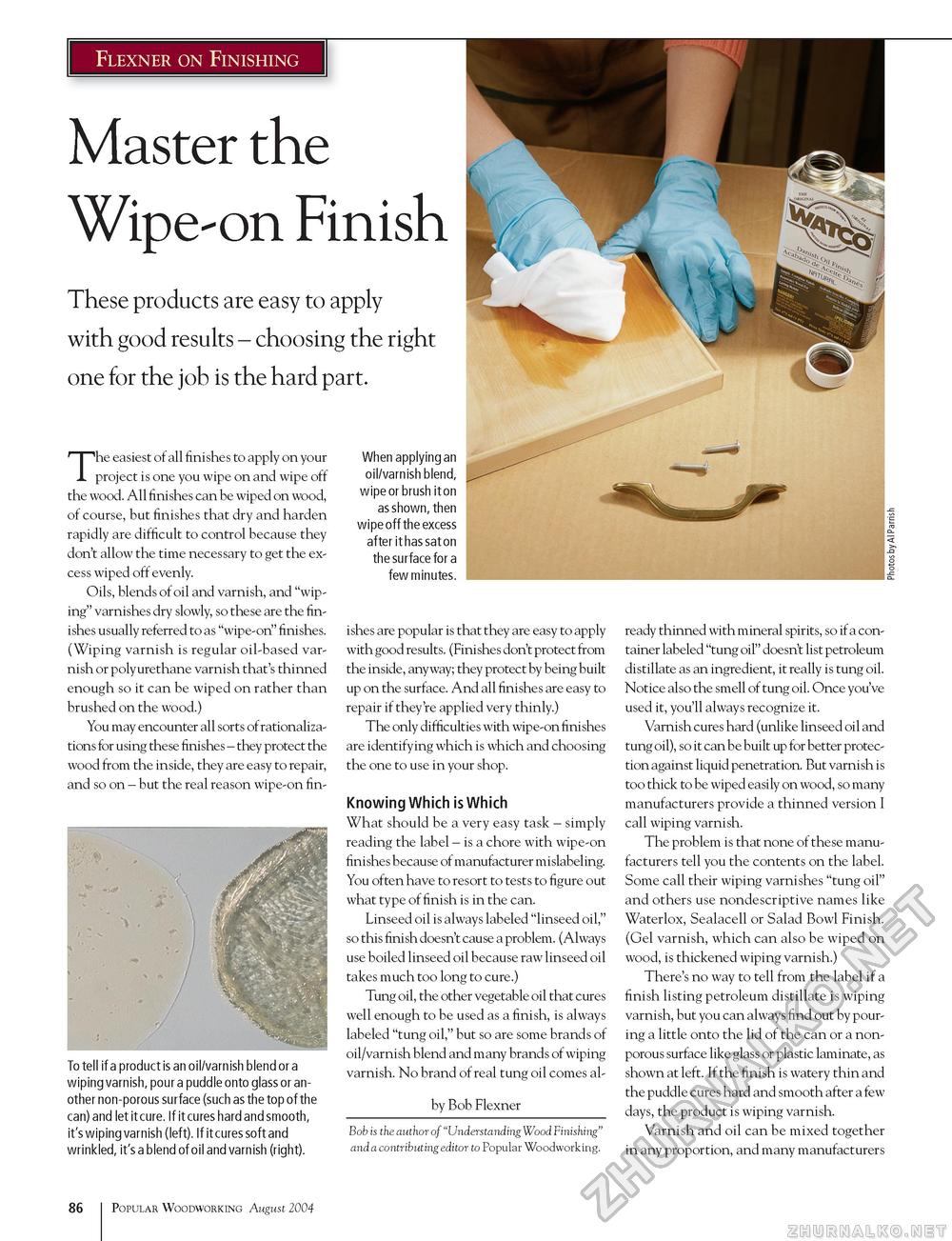Popular Woodworking 2004-08 № 142, страница 88
Flexner on Finishing Master the Wipe-on Finish These products are easy to apply with good results - choosing the right one for the job is the hard part. The easiest of all finishes to apply on your project is one you wipe on and wipe off the wood. All finishes can be wiped on wood, of course, but finishes that dry and harden rapidly are difficult to control because they don't allow the time necessary to get the excess wiped off evenly. Oils, blends of oil and varnish, and "wiping" varnishes dry slowly, so these are the finishes usually referred to as "wipe-on" finishes. (Wiping varnish is regular oil-based varnish or polyurethane varnish that's thinned enough so it can be wiped on rather than brushed on the wood.) You may encounter all sorts of rationalizations for using these finishes - they protect the wood from the inside, they are easy to repair, and so on - but the real reason wipe-on fin- To tell if a product is an oil/varnish blend or a wiping varnish, pour a puddle onto glass or another non-porous surface (such as the top of the can) and let it cure. If it cures hard and smooth, it's wiping varnish (left). If it cures soft and wrinkled, it's a blend of oil and varnish (right). When applying an oil/varnish blend, wipe or brush it on as shown, then wipe off the excess after it has sat on the surface for a few minutes. ishes are popular is that they are easy to apply with good results. (Finishes don't protect from the inside, anyway; they protect by being built up on the surface. And all finishes are easy to repair if they're applied very thinly.) The only difficulties with wipe-on finishes are identifying which is which and choosing the one to use in your shop. Knowing Which is Which What should be a very easy task - simply reading the label - is a chore with wipe-on finishes because of manufacturer mislabeling. You often have to resort to tests to figure out what type of finish is in the can. Linseed oil is always labeled "linseed oil," so this finish doesn't cause a problem. (Always use boiled linseed oil because raw linseed oil takes much too long to cure.) Tung oil, the other vegetable oil that cures well enough to be used as a finish, is always labeled "tung oil," but so are some brands of oil/varnish blend and many brands of wiping varnish. No brand of real tung oil comes al- by Bob Flexner Bob is the author of "Understanding Wood Finishing" and a contributing editor to Popular Woodworking. ready thinned with mineral spirits, so if a container labeled "tung oil" doesn't list petroleum distillate as an ingredient, it really is tung oil. Notice also the smell of tung oil. Once you've used it, you'll always recognize it. Varnish cures hard (unlike linseed oil and tung oil), so it can be built up for better protection against liquid penetration. But varnish is too thick to be wiped easily on wood, so many manufacturers provide a thinned version I call wiping varnish. The problem is that none of these manufacturers tell you the contents on the label. Some call their wiping varnishes "tung oil" and others use nondescriptive names like Waterlox, Sealacell or Salad Bowl Finish. (Gel varnish, which can also be wiped on wood, is thickened wiping varnish.) There's no way to tell from the label if a finish listing petroleum distillate is wiping varnish, but you can always find out by pouring a little onto the lid of the can or a non-porous surface like glass or plastic laminate, as shown at left. If the finish is watery thin and the puddle cures hard and smooth after a few days, the product is wiping varnish. Varnish and oil can be mixed together in any proportion, and many manufacturers 86 Popular Woodworking August 2004 |








